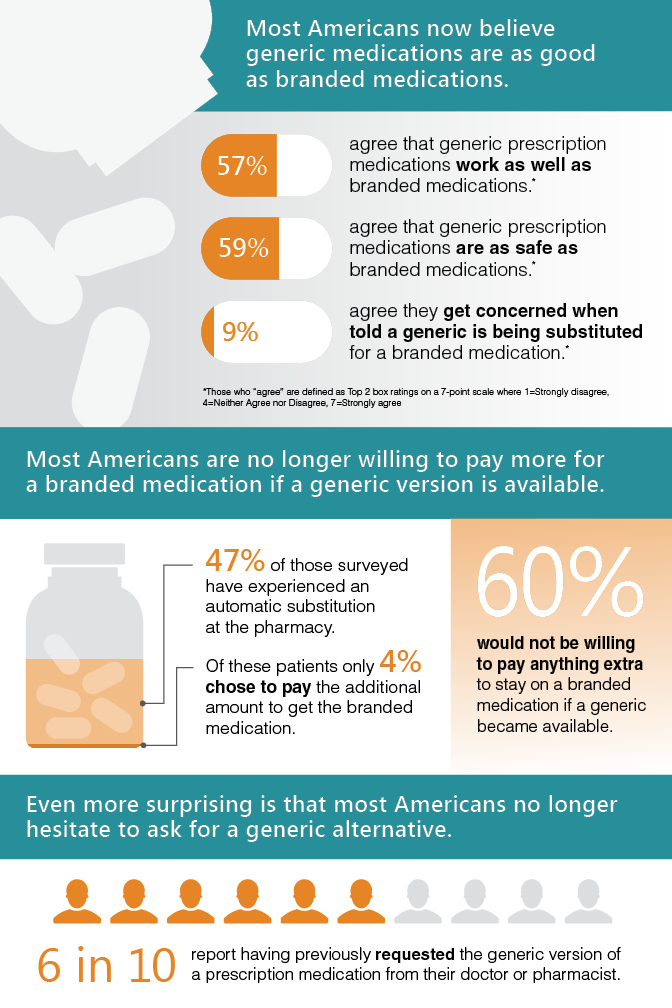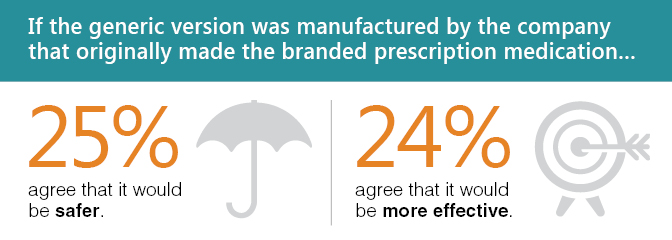Editor’s note: Patrick Lao is a senior research director in the Life Sciences division of Market Strategies International, Hartford, Conn. This is an edited version of a post that originally appeared here under the title, “Living in a generic world.”
“Generic medications are not as good as branded medications.”
“If it costs more, it must be better.”
“If I switch from a branded drug to its generic version, I risk treatment failure.”
With seven in 10 US adults taking at least one prescription medication, and where eight out of 10 prescriptions written are for generic drugs, it has been common to hear these comments from patients and even health care professionals. But according to new independent research from Market Strategies International, these prevalent myths appear to be dying out, and Americans now feel right at home in a world dominated by generics.
According to our study, the majority of U.S. adults now believe that generic medications are just as good as branded medications. Consider the statistics in the infographic below:
This should not be too alarming to most pharma marketers out there though. In my experience conducting market research over the years, patients’ willingness to pay for a branded medication tends to vary not just by their ability to pay but also by the condition they suffer from, the severity of their symptoms and their physician’s opinion.
My personal experience provides an example of this. During the worst allergy season on record last spring, my symptoms became so severe that I found myself reaching straight for branded Claritin. I knew the store-brand generic had the same active ingredients and was likely equivalent to Claritin but, at that moment in time, I really wanted the medication to work and didn’t want to take chances. In hindsight, if my allergy symptoms weren’t that severe on that day, I would have probably chosen the less expensive, store-brand generic.
This anecdote may not be a perfect analogy for choosing a branded prescription medication over a generic substitute (i.e., a non-brand). In my example, I’m essentially choosing between two known brands, Claritin and Walgreens Allergy – Claritin just happens to have much stronger brand equity for me when it comes to allergy remedies.
Which brings us to another interesting finding: One in four Americans still believe that the company that originally made the branded medication could do a better job of manufacturing the generic version.
I’d like to posit two potential reasons that may be driving this lingering perception:
- The ability of a product brand (or corporate brand) to connect with patients and build trust on a differentiated, emotional level may have lasting effects on brand loyalty.
- Patients are not familiar enough with generic drug manufacturers to compare them with brand-name companies, which lead them to assume that generic drug manufacturers may not be held to the same standards.
I’m inclined to think it’s the latter.
There have been recent reports in the media about generic versions of Concerta found to be lacking in efficacy, and about impurities found in generic Lipitor that inhibited the drug’s therapeutic effect. These headlines make it easy for the average consumer to jump to the conclusion that generic drug manufacturers must not be held to the same quality standards as branded-drug manufacturers.
This perception holds true not just among some patients but also among some physicians. Back in 2011, one peer-reviewed study found that half of physicians expressed concern over the quality of generic drugs. During a recent qualitative study, I asked physicians if they would hesitate to prescribe a new medication that is particularly vulnerable to damage if exposed to moisture. We heard a few of them say they would have no concerns about the quality of the product because it is manufactured by a reputable company.
The truth is there are no differences in mandated manufacturing and quality standards between generic drug manufacturing and branded drug manufacturing. The main problem is that the FDA can’t seem to keep up with policing generic drug manufacturers. In their defense though, the FDA has taken considerable efforts over the past few years to crack down on violations. For instance, this past July the FDA issued an alert prohibiting Emcure Pharmaceuticals from importing generic drugs manufactured in their plants in India. But what the average consumer may not know, as our survey findings suggest, is that Indian drug makers like Emcure are actually marketing partners to large multinational drug makers such as Pfizer, Inc., Roche, Novartis and Sanofi. Without knowing this, consumers in large part will continue to have the preconception that branded and generic drug manufacturers are separate entities and are held to different quality standards.
What does this mean for patients?The fact that the majority of Americans have embraced the use of generic drugs is generally a good thing for patients regarding their health care costs. Lowering their out-of-pocket costs allows them to access their medication more easily and can, in part, help increase adherence leading to better outcomes. Payers and policymakers also get to lower overall health care costs when patients switch to a generic medication, which are typically 80 percent -85 percent less expensive than the original branded medication. This amounts to significant savings totaling billions of dollars each week, according to the FDA.
But given the recent reports of quality-control problems and manufacturing violations among generic drug manufacturers, patient advocacy groups and legislators need to push for more funding to allow for better regulatory oversight of generic drugs, more site inspections and more frequent testing of their quality and safety.
What does this mean for pharma marketers?As patients become increasingly accepting of generics, this could signal a stiffer patent cliff once branded products lose exclusivity and create greater urgency for pharma marketers to plan accordingly. Many brands have countered this so called patent cliff by offering co-pay cards and coupons.
The increasing acceptance of drug substitution by patients also poses a challenge to pharma marketers whose branded product faces competition not from automatic generic substitution but rather from therapeutic substitution – that is to say, when a branded prescription medication is substituted with a generic therapy from a different therapeutic class altogether. This is exceptionally maddening to the physicians who have voiced in research that their knowledge and wisdom is superseded, sometimes at a risk to patients. One doctor talks about writing a prescription for an Angiotensin Receptor Blocker (ARB) because of specific non-hypertensive cardiovascular risk factors in a high-risk patient, and the patient instead receives an ACE-inhibitor at the pharmacy, thus undermining some of the secondary effects the physician had hoped for. That is one of many examples.
Our findings also show that of those who received a generic medication at the pharmacy when they were expecting a branded medication, two in five said they accepted the substitution without further discussion. As payers continue to impose tiered co-pays and step-edits to encourage the use of generic therapies, it is likely that therapeutic substitutions both in the physician’s office and at the pharmacy counter will become more prevalent.
- Patients should feel empowered to ask questions so they understand their treatment options.
- The pharma industry should enable dialogue between physician, patient and insurer about therapeutic substitution and the implications for that patient.
These discussions between patient and provider will become increasingly important as more biosimilars enter the market, and third-party payers decide whether biosimilar substitution should be allowed without a patient’s knowledge or consent.
Study findings are based on a nationwide sample of 1,000 consumers, and we have uncovered a few surprising differences in their perceptions of generic drugs based on age, income and race/ethnicity.


